Zylstra Lake: Fall Trail Times 2020
Posted October 29, 2020 at 5:45 am by Tim Dustrude
 Thanks to the cooperation of the Land Bank and the San Juan Preservation Trust we now have a beautiful new and historic public land to explore.
Thanks to the cooperation of the Land Bank and the San Juan Preservation Trust we now have a beautiful new and historic public land to explore.
On September 26th, National Public Lands Day, 5 years of negotiations and planning came to fruition when the 285-acre Zylstra Lake Preserve on San Juan Island officially opened part of its roughly three mile loop to the public.
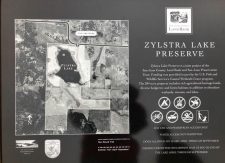 The trail which runs approximately one mile along the eastern side of the lake is closed from October to April to protect migrating waterfowl. Dogs on leashes are allowed on the 1.6 mile trail illustrated below (3 mile total out and back) until November 1 and allowed again in April for the full loop. Leave no Trace, pack in and pack out.
The trail which runs approximately one mile along the eastern side of the lake is closed from October to April to protect migrating waterfowl. Dogs on leashes are allowed on the 1.6 mile trail illustrated below (3 mile total out and back) until November 1 and allowed again in April for the full loop. Leave no Trace, pack in and pack out.
Fall, even at this crisp crust of the season, is a great time to hike. As leaves colorfully flair and drop, a whole new landscape appears. On a gorgeous sunny Fall Sunday we enjoyed the Zylstra Lake trail opening along with many other eager walkers. Begin at the parking just off San Juan Valley Road. A trail map there gives a good overview of the area you will be traveling.
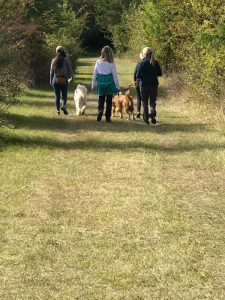 Continue west down the old farm road’s grassy slope bordered with blackberry, snow berry, red current, wild grape and hawthorn trees festooned with bright red berries. These ornamental invasive trees were introduced to the island in the 1850’s by the Douglas family. James Douglas was head of the Hudson Bay Company’s Belle Vue settlement and sheep farm which was run by Charles Griffin.
Continue west down the old farm road’s grassy slope bordered with blackberry, snow berry, red current, wild grape and hawthorn trees festooned with bright red berries. These ornamental invasive trees were introduced to the island in the 1850’s by the Douglas family. James Douglas was head of the Hudson Bay Company’s Belle Vue settlement and sheep farm which was run by Charles Griffin.
Stop here for an overlook of the lake. Hawthorns naturalized easily. Native tribes used their thorns as spikes on the prongs of rakes to catch herring, or for fish hooks or ear piercing.
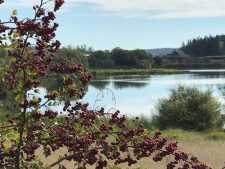 As you continue down the road you will see red barked Madrona towering over a diverse understory. Weighed down in Fall with clusters of reddish fruit these Madrona treats are coveted by our bird residents, including robins and varied thrushes.
As you continue down the road you will see red barked Madrona towering over a diverse understory. Weighed down in Fall with clusters of reddish fruit these Madrona treats are coveted by our bird residents, including robins and varied thrushes.
The Zylstra Lake area has a fascinating history. In the 1850s the Old Military Road, the vital link between American and English camps, followed False Bay creek and traveled right through what is now Zylstra Lake. Back then you would have seen horseback riders from both English and American camps trotting past you here, relaying important messages or on the way to horse races and social activities.
False Bay Creek helped make this valley’s fertile soil a place where Salish tribe natives collected nutritious camas bulbs and hunted for deer. In historic times wolves and an occasional bear were still found on the island.
These rich lands, easily accessible from the Military Road and it’s offshoots, also appealed to early homesteaders for raising grains, planting orchards or grazing cattle, hogs and sheep. One such homesteader was James Archambault. James, on whose 160 acres you are now treading, married Mary Delaunais, a Cowlich native in 1863. They had 14 children. Native wives of early settlers played an essential role in the settling of the islands and for the survival of these early families.
In historic reports of settlement…”not memorialized were the young indigenous women who lived where forts were built and settlers staked claims that displaced native communities…Indigenous wives occupied a middle ground between people of alien cultures…White women praised their mothering, homemaking skills, and knowledge of natural medicines. Indigenous midwives delivered settler’s babies and taught them how to cook local food stuffs…” and were often mediators when disputes arose. (Peace Weavers/Candace Wellman)
To homestead, settlers needed to ‘prove up’ their land. They had to live on their claim within six months and settle and cultivate it for fourteen months before they could qualify to purchase it for a small price, or sans cash, show various improvements after 5 years. James and Mary built a house and barn and cultivated oats and an orchard.
About 1/4 mile down the trail a red alder grove provides a shaded walkway, especially appreciated in the summer. Salish natives ate the slimy cambium tissue under the red alder bark raw, mixed with oil, or dried into cakes for winter. The bark is also used for smoking salmon, imparting sweetness to the fish.
Continue around the bend and see if you can spot, almost hidden by willow trees, a part of False Creek with remnants of an old trail or road.
Travel up the gentle slope and note the preserved farmland lakeside. Dried blossoms of spirea nestle under fir, shore pine, and an occasional blue spruce. Low on the littered fall floor, a multitude of mushrooms can be found. Mushrooms, neither plant nor animal, have an important role in our forests.
As fungi, with no chlorophyll, they must live on other organic material and thus have a great role in the breakdown and recycling of the forest. In fact, it is said without fungi life could not exist. (Please don’t pick – the one in the photo had already fallen over.)
As you head down the slope and enter an open field area look up to see an active Bald Eagle’s Nest. The abundant water fowl in the lake makes this habitat a rich one for many species. Listen for our native tiny but loud, tree frog. More shore pine and alder line the trail. After an environment has been disturbed, alder are an important first generation tree that helps set nitrogen for future successions.
Moving along the west side at approximately 3/4 mile you will come closer to the lake for a wetlands view of willows, cattails and canary reed grass. Cattails were a useful plant for native tribes. Their leaves and stalks are great for weaving into baskets, mats, hats, pack sacks and bedding and many parts are edible. I have even heard of the fluffy white tops being used for diaper material.
Cattail habitat has been encroached by invasive canary reed grass reportedly encouraged by a Corps of Engineers agent in the 1920s. This wetlands area is one of the reasons the preservation project was able to get the much needed Federal Coastal Wetlands grant. Zylstra Lake is part of an important watershed, connected upstream with False Creek and downstream with False Bay and out to sea.
Now you have entered what was the homesteading claim of Catherine Vermouth. Beginning with the Homestead Act in 1862 any head of household or single individual, including women, over twenty-one years could file for 160 acres. Catherine was the daughter of a Kanaka (Hawaiian), John Bull, who was a shepherd with the Hudson Bay’s Belle Vue Sheep Farm from 1854-1860 and Fu-hue-wut Mary Skqulap, a Lummi/Clallam. Catherine and her 2nd Kanaka husband’s ‘proving up’ consisted of a log house, barn, chicken house, fencing, orchard, and 40 acres in crops. (Boyd Pratt/Zylstra Lake Cultural assessment)
Over the years these homesteads were bought, sold and divided many times until Fred and Rena Zylstra and Ernest and Dodie Gann bought up most of what had become known as San Juan Valley Farms, Inc.
Who the heck was Zylstra? Fred Zylstra arrived in the US from Holland in 1919 at seventeen years old. He and his wife, Rena, whom he married in 1923, moved often around Western Washington until in 1945 they founded Northwest Kitchencraft and then Rena Ware, and a fortune in stainless steel cookware was made. They bought this property in 1960 and named the enterprise Wooden Shoe Farm. In 1963 they created this 48-acre lake to improve irrigation, especially needed during our dry summers. The dam provided water for pure-bred Herefords, a cash crop of holly and about 400 acres of San Juan Valley farmland. At the time the lake was touted ‘the largest private man- made lake in Washington.’ (Boyd Pratt)
At almost 1 mile, stay on the straw covered trail toward the fence designating the Agricultural easement still used for haying. Agricultural easements are an important part of land conservation. Small scale agriculture, especially organics, are now an important local industry for our island farmers.
In the 1900s San Juan Island grew many agricultural crops for shipping. In the 1920s and 30s the San Juan Island Cannery near where the Port of Friday Harbor offices are today processed the lucrative island pea crop. The Cannery had bought up the farms of several first family settlers, like Mary Gormans who had homesteaded just east of you. In 1939, however, the floor of the cannery collapsed and sent 10,000 cases of canned peas onto the Harbor’s floor. Fished out and repackaged, the next year brought the pea weevil and an end of the industry. (Boyd Pratt)
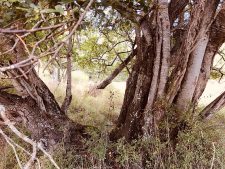 Just after a mile go west away from the lake to the small upland forest loop of shore pine and big leafed maple. Look for Zylstra’s distinctive concrete post fencing and as you begin the grade keep an eye out for this beautiful old Scouler willow. Further up the grade lichenized erratic rocks sport a miniature ecosystem including mosses like Juniper haircap. Lichen are actually two plants in one, a symbiotic combination of a fungus and an algae; the alga provides the photosynthetic food, the fungus storage and support. These rocks merit a closer look at a miniature world.
Just after a mile go west away from the lake to the small upland forest loop of shore pine and big leafed maple. Look for Zylstra’s distinctive concrete post fencing and as you begin the grade keep an eye out for this beautiful old Scouler willow. Further up the grade lichenized erratic rocks sport a miniature ecosystem including mosses like Juniper haircap. Lichen are actually two plants in one, a symbiotic combination of a fungus and an algae; the alga provides the photosynthetic food, the fungus storage and support. These rocks merit a closer look at a miniature world.
Where did the huge rocks come from? Most of you know that San Juan Valley was once covered by sea but before that time a mile high ice sheet existed as far south as Olympia. When it receded it left these huge rocks called erratics, with a makeup usually different than our surrounding strata.
Over sixty of the hundred species of birds found in the Preserve can be seen or heard here seasonally by the astute observer. Keep your eyes and ears open for our year around juncos, chickadees, nuthatches, kinglets, wrens, Pine Siskin and woodpeckers. There is one woodpecker who spends more time feeding on the ground than in a tree, the Northern Flicker whose barbed and sticky tongue can extend two inches to capture wiggly insects. A white rump patch is a good identifier as well as their bright salmony wing feathers, prized by native tribes.
You may have also been impressed by the amount of Old Man’s Beard lichen hanging from trees, a good sign of healthy air quality. This loop is a good place to be looking high and low. You might get snagged by burdock, hoping it’s seeds will travel with you to disburse, no doubt where you don’t want them. Burdock burrs are pretty famous as they were the model which a Swiss inventor, George de Mestral used for the hook-and-loop system leading to the invention of Velcro. As you head down the slope back toward the lower lake your foot may brush against some aptly named purple blossomed skunk weed or white flowered stinking chamomile.
At around a 1.5 miles are great views over the valley and on a clear day Mt. Baker.
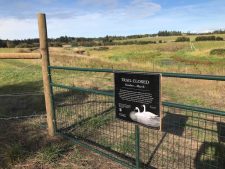 A little farther down the trail stop at the southern tip of the Preserve trail gate for a good look at the lower lake, dam, and upper lake. During winter up to 20 species of waterfowl, like widgeons, mallards, and the elegant Trumpeter Swans can be seen here. Be sure to bring your binoculars! Come April when migratory birds have departed for northern climes, you will be able to complete the loop, walk over the dam and up the old farm road to the parking lot, making a 3+ mile loop.
A little farther down the trail stop at the southern tip of the Preserve trail gate for a good look at the lower lake, dam, and upper lake. During winter up to 20 species of waterfowl, like widgeons, mallards, and the elegant Trumpeter Swans can be seen here. Be sure to bring your binoculars! Come April when migratory birds have departed for northern climes, you will be able to complete the loop, walk over the dam and up the old farm road to the parking lot, making a 3+ mile loop.
We are so lucky to have this new Preserve available to the public. Working together the Land Bank and Preservation Trust have an important job they do so well and also rely on our help and input. Besides providing a diverse habitat, Zylstra Lake is still used for irrigation, needs that have to be balanced with sending enough uncontaminated water through the remainder of the False Creek Watershed, out into nearby False Bay and into the Haro and Juan de Fuca Straits. False Bay creek may also be a missing migratory link for Cut Throat Trout and salmon, an exciting prospect.
Article submitted by Robin Donnelly for the Old Military Road Trail (OMRT) committee
It is hoped that in commemoration of the role the Old Military Road took in establishing a peaceful settlement, the Preserve trail you just walked will be included in our Old Military Road Trail (OMRT) system. For more information or to join us see OldMilitaryRoadTrail.org.
You can support the San Juan Update by doing business with our loyal advertisers, and by making a one-time contribution or a recurring donation.
Categories: Environment, Fitness, History, Nature, Recreation, Trail Times
2 comments:










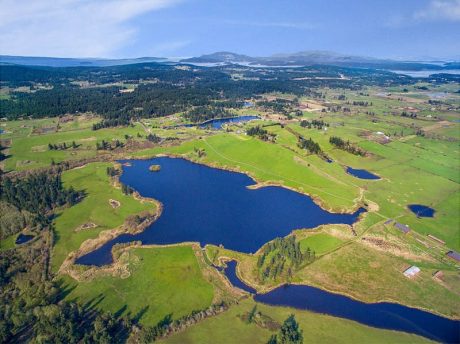
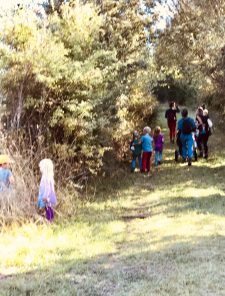
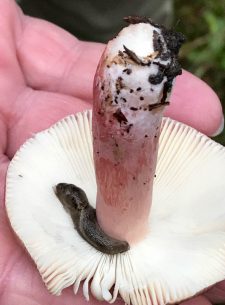
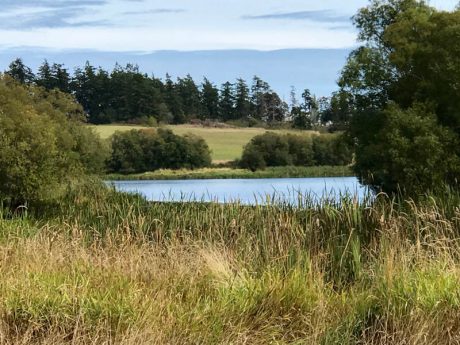
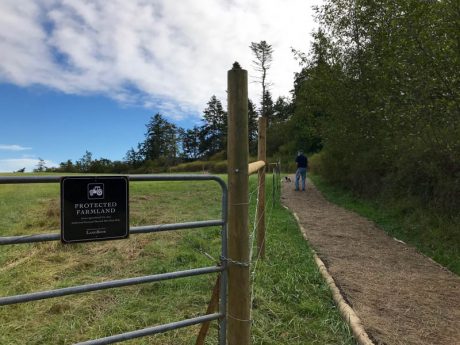
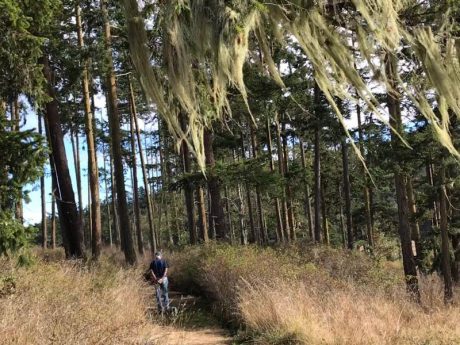
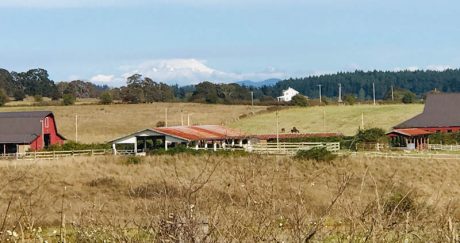
2 comments...
Wonderful article. Thank you. Lets also keep alive the discussion of swimming and sailing in the lake, as was originally planned for this purchase
Such interesting history. I love that this has been preserved and kept in its natural state. I hope that the property is treasured, respected enjoyed . I would be sad to see any sort of recreation or sports brought to this pristine property such as swimmming (think sunscreen pollution) sailing (think vehicles, parking, ).
By submitting a comment you grant the San Juan Update a perpetual license to reproduce your words and name/web site in attribution. Inappropriate, irrelevant and contentious comments may not be published at an admin's discretion. Your email is used for verification purposes only, it will never be shared.